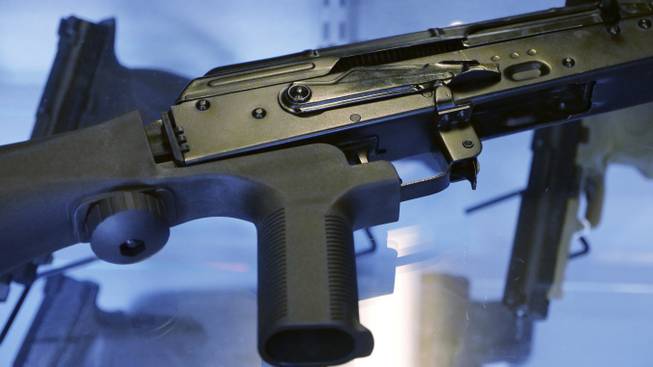
Rick Bowmer / AP
In this Oct. 4, 2017, photo, a device called a “bump stock” is attached to a semi-automatic rifle at the Gun Vault store and shooting range in South Jordan, Utah.
Tuesday, Jan. 17, 2023 | 2:54 p.m.
U.S. Rep. Dina Titus of Nevada and two other lawmakers today introduced a bill to ban rapid-fire bump stocks for rifles after a federal judge struck down a ban implemented by the Trump administration.
Bump stocks are aftermarket devices that allow a shooter to rapidly fire multiple rounds using the recoil of a semiautomatic rifle.
The federal Bureau of Alcohol, Tobacco, Firearms and Explosives sought to ban the device after a gunman on Oct. 1, 2017, used bump stocks in a mass shooting in Las Vegas. A total of 60 people died and hundreds more injured in the deadliest mass shooting in U.S. history.
Titus, a Democrat, said that shooting was one of the reasons she introduced the bill, along with Reps. Dan Kildee, a Democrat from Michigan, and Brian Fitzpatrick, a Republican from Pennsylvania.
“Over five years after the deadliest mass shooting in our nation’s history occurred in my district, we still have not permanently outlawed bump stocks,” Titus said in the statement.
“We must reverse the unfortunate trend of inaction in Congress on gun violence prevention. If we do nothing, especially in light of recent judicial action, we risk allowing the use of bump stocks to be legal and more lives to be lost,” she said.
Kildee also issued a statement, saying “devices like bump stocks that turn firearms into fully automatic machine guns have no place on our streets.”
The bill would treat bump stocks the same as machine guns, making it illegal to manufacture, sell or possess them for civilian use. It would also cover other parts and modifications that increase a gun’s rate of fire.
Earlier this month, a 13-3 ruling of the 5th U.S. Circuit Court of Appeals struck down the Trump-era ban on bump stocks.
The decision, however, didn’t have an immediate effect on the ban because the case went back to a lower court to proceed and may ultimately be decided by the U.S. Supreme Court.
Opponents of the ban say bump stocks do not fall under the definition of illegal machine guns in federal law.
The ATF says they do, a position being defended by the Biden administration.
The court found the definition of a machine gun — which is set out in two different federal statutes — “does not apply to bump stocks.”
The ban had survived challenges at the Cincinnati-based 6th U.S. Circuit Court of Appeals; the Denver-based 10th Circuit; and the federal circuit court in Washington.
A panel of three judges at the 5th Circuit also issued a ruling in favor of the ban, upholding a lower-court decision by a Texas federal judge. But the full New Orleans-based court voted to reconsider the case. Arguments were heard Sept. 13.
Bump stocks harness the recoil energy of a semiautomatic firearm so that a trigger “resets and continues firing without additional physical manipulation of the trigger by the shooter,” according to the ATF.
A shooter must maintain constant forward pressure on the weapon with the nonshooting hand, and constant pressure on the trigger with the trigger finger, according to court records.
The full appeals court on Friday sided with opponents of the ATF rule.
They had argued that the trigger itself functions multiple times when a bump stock is used, so therefore bump stock weapons do not qualify as machine guns under federal law.
They pointed to language in the law that defines a machine gun as one that fires multiple times with a “single function of the trigger.”
The Associated Press contributed to this report.
